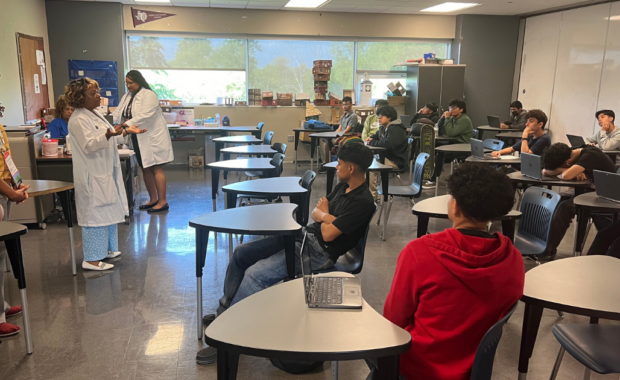5 Ways to Incorporate Social Determinants of Health to Improve Patient Care
PA Educator Advocates for Underserved Populations
July 8, 2021
Want to improve patient care? A PA educator calls for seeking new information and data about patients, particularly when treating underserved and minority populations. A recent AAPA webinar suggests five ways PAs can enhance understanding of and care for patients.

Daytheon Sturges, PhD, MPAS, PA-C, CAHIMS, CHES, assistant professor at the University of Washington MEDEX Northwest PA program, led AAPA’s webinar on “The Role of Social Determinants of Health in Clinical Practice and Subsequent Health Outcomes,” and describes how PAs can incorporate social determinants of health into patient care.
- Dig deep into patients’ personal history, backgrounds, genetics
Medicine is a conglomeration of different specialties, Sturges says. “We have to look into public health, health promotion, and health education. We also have to dig deeper into medical anthropology and history itself to understand our patients and the life experiences that they bring to the clinic or when they see us at the hospital.”
Consider how life experiences, traumas and stigma have influenced health behaviors in minority populations, says Sturges, including historical trauma such as slavery, Japanese internment camps during WWII, the government’s introduction of the Tuskegee experiment, and police violence and civil and racial unrest, especially in 2020.
“Black Americans are carrying an increased cognitive load of fear and anxiety surrounding the safety of their sons and daughters. And on the right, we can’t forget our LGBTQIA+ and transgender brothers and sisters who are being oppressed. When our patients come in, they are more than a body in a seat – they bring experience and historical traumas.”
Another way to look at patient history is by considering their genetic background. The National Institutes of Health’s All of Us Research Program is a longitudinal effort to gather health data from one million or more people to build one of the most diverse health databases in history. The program aims to reflect the diversity of people living in the U.S. and to include participants from groups that have been underrepresented in health research in the past. The health data collected through All of Us will help researchers better understand how genetics, environmental factors, and life circumstances affect health outcomes and equip them to uncover paths toward delivering individualized prevention, treatment, and care for all populations.
Sturges says: “It is important to move beyond race-based medicine and to consider the true biological/genetic and environmental contributors to health. All of Us is a novel approach to move toward health equity through increasing diversity in medical research. I encourage us to participate so that we are all represented in the findings, which will aid in the closing of health disparity gaps.”
- Consider education, language, and literacy
In addition to personal history and genetics, think about patient education, language of origin, and health literacy. Often, patients leave a clinician’s office retaining about 50% of the information shared, and by the time they get home, they’ve only retained about 20%. Approach everyone from their level of understanding.
Also, consider language and literacy skills. First, Sturges recommends utilizing medical interpreters instead of family members when possible. “When you’re using an interpreter look at the patient to connect and talk to them as if their interpreter is not there.”
He says don’t assume just because someone says they speak English that it is their preferred language. “We can’t assume that everyone has the same skills and can read and understand the information that we’re giving.”
“For example, I had a patient who I didn’t feel trusted me until two years after I started seeing her. She finally told me that she reads at a first-grade level. And I always wondered, ‘Why aren’t you retaining this information? I’m doing everything I can, I’m giving you this information.’ And then I found out that she couldn’t even read what I gave her. So that’s why it’s important to see what the patient’s literacy levels are. Work on gaining rapport with your patient to have these deeper conversations to get to the heart of that person sitting in front of you.”
- Be aware of the impacts of housing, transportation, and neighborhoods
Among other social determinants of health are safe housing, levels of transportation, and the types of neighborhoods in which people live. Regarding safe housing, consider if there are asbestos or rodent problems. Is there mold? Is there public transportation?
“Sometimes when we set up patients to go see specialists, we need to ask if they have transportation to get there. And if not, can we provide resources for them to have access to who we want them to see? Or when patients are late, do we just get mad and say, ‘Oh, they do this every week and they’re not compliant?’ Or do we ask if the patient has a car that isn’t reliable or rides the bus and takes lots of bus transfers? These are the conversations that help us connect with and understand our patients,” Sturges says.
Sturges gives an example of prescribing 30 minutes of cardiovascular exercise to help bring down a patient’s blood pressure. He says, “If they don’t do it, we might get upset and say, ‘Oh, this patient is non-compliant and does not uptake my therapy lifestyle changes.’ But do we know where they live? Is it an area that has no trees and is very hot outside to walk? Is their neighborhood walkable? Does it have parks? Does it have crosswalks or sidewalks? Is it dangerous? These are some of the things we have to consider.”
- Look to Healthy People 2030 for health equity guidance
During the webinar, Sturges defines health disparities, equality, and health equity. Health equity is giving everyone what they need to be successful, while equality is treating everyone the same and promoting fairness. But, he says, it can only work if everyone starts at the same place. We want to remove the barriers that are preventing patients from receiving proper healthcare to foster more sustainable health outcomes for them as well as the communities in which they live, he explains.
“We now have 2030 guidelines that set national health goals across a 10-year time frame,” Sturges says. “And this includes social determinants of health as a standalone topic area.” Some of the main areas emphasized are education access, quality of education, health care access, and the healthcare neighborhood.
“I would recommend going to Healthy People 2030 as a resource. The social determinants section of their website has lots of infographics, go-to advice, as well as data. You also can link to health disparities in the minority health section of the CDC website or look at your county and state health department information, baseline data, and health disparity data.”
- Explore how practices and policies affect individual health, families, and communities
Another way to impact patient care, according to Sturges, is to gather knowledge by talking to your interprofessional team, social workers, health educators, public health officials, or those who work in a health equity office.
“Learn about the programs, practices, and policies that can help your patients and [those] that impede the health of your patients,” says Sturges. “Ask yourself, ‘How can we provide health for all and establish common goals with our patients?’”
Understanding health behavior takes time, and so setting common, attainable goals and building on those helps to get good health outcomes. Sturges recommends considering who else can help in the treatment of patients, such as a social worker to discuss resources, or other healthcare professionals. If PAs maintain an ongoing, constructive relationship with their patients, sometimes they can be an intermediary between the health sector and all these other areas.
PAs can also encourage their patients to get involved in programs like the All of Us Research Program, which will enable them to learn about their own health while simultaneously contributing to research that may lead to important health breakthroughs and improve outcomes for future generations.
Cultural competence leads to healthier outcomes
Giving medical advice without accounting for existing barriers can lead to suboptimal patient health outcomes, Sturges says. “Cultural competency is not a one-and-done thing – you don’t get a badge to say that you are culturally competent; it is a lifelong process. You can learn something from each patient, each interaction, and from your outside reading. This way we strive to become culturally humble, and then can improve quality of care in this healthcare system. Successful health outcomes feed into mortality and morbidity rates, and how much money is being spent on health care.”
Daytheon Sturges has been a PA since 2008 and a PA educator since 2013. He is an assistant professor at the University of Washington MEDEX Northwest PA program, and serves as the Associate Program Director of Regional Affairs, Justice, Equity, Diversity, and Inclusion (JEDI). He is also the JEDI Committee chair for the Department of Family Medicine, while still maintaining clinical practice in family medicine within the UW system. He serves as the chair of PAEA’s Diversity and Inclusion Mission Advanced Commission and as the JEDI feature editor for the Journal of Physician Assistant Education. His passion is providing care to underserved populations. Contact him at [email protected] or @daytheon on Twitter.
You May Also Like
NIH All of Us Research Program
Social Determinants of Health CME
PAs Say Genetics and Genomics Key to Patient Diagnosis and Treatment
PAs: Get Involved in Genetics to Help Patients



